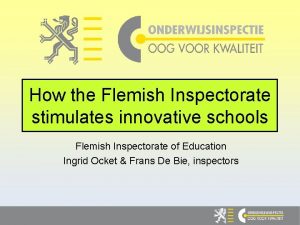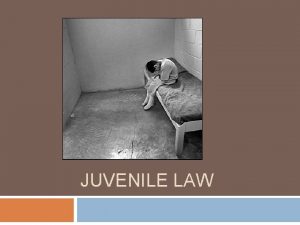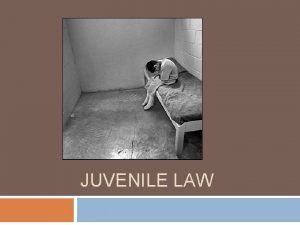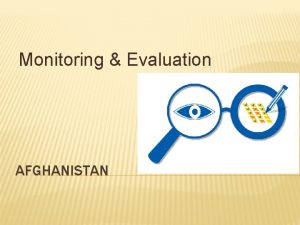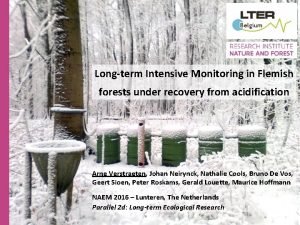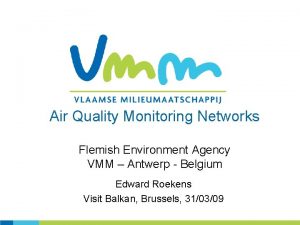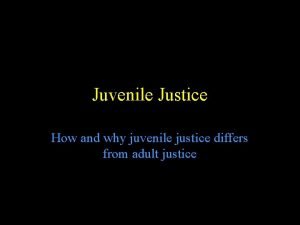Monitoring and evaluation of the new Flemish juvenile













- Slides: 13

Monitoring and evaluation of the new Flemish juvenile justice system Eef Goedseels Emma Hadermann

Monitoring and evaluation of the new Flemish juvenile justice system 1. Introduction 2. Research questions 3. Methodology 4. Ending note 5. Questions 2

1. Introduction • Until 2014: one federal code applicable to juvenile offenders • 6 th state reform in 2014 • Communities competent in this matter • Each must develop own legislation to replace the federal code • Flemish decree approved on 6 February 2019 Entered into force gradually from 1 September 2019 3

1. Introduction • Great importance to scientific foundation of the system • Evidence-based working as a guiding principle • Systematic monitoring and evaluation • Art. 88 = report on the evaluation of the decree within 3 years Develop a good research design Baseline measurement 4

2. Research questions (RQ) 1. What are the main objectives and intended changes of the new Flemish decree? And which indicators are relevant for the evaluation? 2. What data is available on the functioning of the current juvenile justice system? And also what is the quality of the registered data? 3. What additional data is needed in order to achieve a good baseline measurement? 5

2. Research questions (RQ) 4. What is the current state of functioning of the juvenile justice system, taking into account both the available and the additional data? 5. What is a useful research design for the structural monitoring and evaluation of the Flemish decree? 6

3. Method 1) 11 goals based on the decree’s text and the explanatory statement (RQ 1) 1. Legal guarantees 6. Focus on the responsibility of the juvenile offender 2. Working with different frameworks (ex. need for help, punishment, …) 7. Clear reactions 3. A tailor-made response for juvenile offenders 8. Fast reactions 4. Subsidiarity and closed placement as last resort 9. Restorative reactions: prioritize remediation 5. Clear difference between the legal reaction and the need for help 10. Constructive reactions 11. Evidence based reactions 7

3. Method 2) Make goals measurable • Goals subgoals actions indicators • Side-effects: contra indications A. Clear answer Subgoal Action Indicator 1. Communicate in a language understandable for the juvenile offender 1. 1 Guarantee that professionals posses enough skills to communicate to the juvenile offenders 1. 1. 1 Professionals have enough background to communicate with juvenile offenders and their context (verbally and written) B. A tailor-made answer for juvenile offenders Subgoal 1. Expanded and flexible possibilities to answer to juvenile offenders 8 Action Indicator 1. 1 Guarantee the diversification of answers in order to provide an alternative for placement in a closed center 1. 1. 1 The public prosecutor makes use of its new possibilities to react >< contra: this can result in net widening

3. Method 3) Identify overlap between actions and indicators • References made to the place where actions/indicators fitted best • ~ a link between indicators • “see” overlap between indicators • Extent of framework reduced without losing valuable information B. A tailor-made answer for juvenile offenders Subgoal 1. Expanded and flexible possibilities to answer to juvenile delinquency 2. The answer is tailor-made for every involved party 9 Action 1. 1 Guarantee diversification of reactions to be able to provide an alternative for closed placement ~ D. Subsidiarity and last resort Indicator 1. 1. 1 The public prosecutor makes use of its new possibilities to react >< contra: this can result in netwidening ~ A. 2. 1. 1 en H 1. 2 en D. 1. 1. 2 2. 3. The victim is adequately See J. 1. 2. 1 tem J. 1. 2. 3 approached in the context of providing an answer to the juvenile offender

3. Method 4) Baseline measurements of aspects expected to change according the decree • Qualitative/ quantitative information available concerning the indicators? (RQ 2) • Yes no extra measurement • No baseline measurement needed (RQ 3) • The information can be collected retroactively in three years (ex. Recorded in databases) • Information needs to be collected as soon as possible (ex. perception of juvenile offenders on changing procedures) 10

3. Method 5) Clear image of the situation before the coming into force (RQ 4) • Data collected now + data collected retroactively 6) Elaboration of the research design for the monitoring and evaluation (RQ 5) • What qualitative/quantitative research is needed to execute the monitoring and evaluation? 11

4. Ending note • Not only focus on effectiveness with quantitative data • Also attention for • Experience and perception of the juvenile offender and the other involved parties • Using qualitative research: in depth interviews, focus groups … 12

Questions? 13
 King closer brick
King closer brick Flemish and dutch difference
Flemish and dutch difference Falling leaves metaphor
Falling leaves metaphor Flemish floral design
Flemish floral design Objectives of flower arrangement
Objectives of flower arrangement List three types of hard goods used in floral design
List three types of hard goods used in floral design Sergeant of the law canterbury tales
Sergeant of the law canterbury tales Stretcher bond t junction
Stretcher bond t junction Hogarthian curve
Hogarthian curve Flemish giant colors
Flemish giant colors Italian vs northern renaissance
Italian vs northern renaissance Good morning in flemish
Good morning in flemish What is visitor pre registration in picme
What is visitor pre registration in picme Project cycle management ngo
Project cycle management ngo














